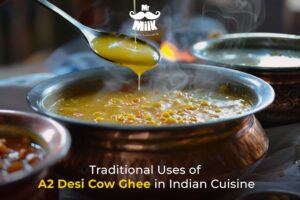Traditional Uses of A2 Desi Cow Ghee in Indian Cuisine
A2 Desi Cow Ghee, a staple in Indian kitchens for centuries, is not just a cooking ingredient but a symbol of nourishment, tradition, and health. Derived from the milk of indigenous cow breeds like Gir and Sahiwal, A2 ghee is cherished for its purity and rich nutritional value. It holds a special place in Indian households, not only for its ability to enhance the flavour of food but also for its deep-rooted connection to Ayurveda and our cultural heritage.
In this blog, we explore the traditional uses of A2 Desi Cow Ghee in Indian cuisine and why it continues to be an essential part of our diet.

1. A2 Ghee for Tadka (Tempering):
One of the most common uses of A2 Desi Cow Ghee in Indian cooking is for tempering, known as tadka. Whether it’s dal, sabzi, or chutneys, adding a tadka of spices like cumin, mustard seeds, and curry leaves in ghee infuses a rich aroma and flavour. The ghee acts as a carrier for the spices, enhancing their natural taste and adding a unique depth to the dish.
2. A2 Ghee in Rotis and Parathas:
In Indian households, ghee has been traditionally used to make rotis, parathas, and puris more delicious. A simple drizzle of A2 Desi Cow Ghee over hot chapatis or spreading it over parathas elevates their taste and adds a layer of richness. In many homes, making “ghee rotis” for children is a common practice, providing them with essential fats and energy for the day.
In states like Punjab and Rajasthan, ghee is a must for making parathas stuffed with vegetables or paneer. The ghee not only adds flavour but also keeps the parathas soft and moist.
3. A2 Ghee for Sweets and Desserts:
No Indian celebration or festival is complete without ghee-laden sweets. A2 Desi Cow Ghee is a key ingredient in making traditional Indian desserts such as halwa, laddoos, barfis, and kheer. The use of ghee gives these sweets their characteristic richness and enhances their texture. Ghee is what makes these sweets melt in your mouth, leaving behind a lingering aroma and taste.
Whether it’s preparing a decadent gajar ka halwa during winter or making besan laddoos during Diwali, A2 Desi Cow Ghee plays a vital role in bringing out the sweetness and flavour of these traditional treats.
4. A2 Ghee in Rice Preparations:
Indian cuisine features a variety of rice dishes, and A2 Desi Cow Ghee is often used to enhance their taste. Biryani, pulao, khichdi, and jeera rice are all cooked with ghee to bring out their authentic flavours. The ghee coats the rice grains, making them more flavorful and aromatic.
One of the most traditional uses is adding a spoonful of ghee over freshly cooked rice, especially when served with dal or rasam. This simple combination of rice, ghee, and dal is comforting and highly nutritious.
5. A2 Ghee for Ayurvedic Cooking:
In Ayurveda, A2 Desi Cow Ghee is considered a superfood. It is used in several Ayurvedic preparations and is known to balance the body’s doshas. Ayurvedic recipes often recommend cooking vegetables, grains, and even herbal medicines in ghee to improve digestion and enhance nutrient absorption.
Ghee is also consumed with warm milk to promote good health, improve digestion, and support overall immunity. A teaspoon of ghee mixed with milk or consumed on an empty stomach is believed to nourish the body from within.
Read More About The use of A2 cow ghee in Ayurveda And Other Traditional Healing Practices
6. A2 Ghee in Daily Meals:
For generations, Indian mothers and grandmothers have been adding ghee to everyday meals. Whether it’s stirring a little ghee into dal or spreading it on hot rice, ghee is an essential part of daily Indian food. It helps in lubricating the joints, aids digestion, and boosts energy levels. Even traditional dishes like khichdi, Pongal, and upma are incomplete without a dollop of ghee, which adds a comforting richness to these meals.
Read More:Simple and Delicious Ways to Enjoy A2 Cow Ghee Every Day
7. Ghee in Fasting Recipes:
During fasting periods, such as Navratri or Ekadashi, ghee is often used in the preparation of sattvic food. Dishes like sabudana khichdi, rajgira puri, and kuttu ki roti are cooked in ghee to maintain their purity and energy-boosting properties. Ghee is also added to special fasting sweets like makhana kheer and singhare ke atte ki burfi, providing nourishment while adhering to traditional fasting practices.
Why Choose Mr Milk’s A2 Desi Cow Ghee?
Mr Milk’s A2 desi cow ghee is crafted using the traditional bilona method, ensuring that each jar of ghee is pure, nutritious, and rich in flavour. Made from the milk of happy and healthy desi cows, Mr Milk’s ghee is a testament to quality and tradition.
Conclusion:
A2 Desi Cow Ghee has been an integral part of Indian cuisine for centuries. Its versatility, flavour, and numerous health benefits have earned it a permanent place in our kitchens. From tadkas to sweets, rotis to rice dishes, ghee continues to be a symbol of nourishment and love in Indian cooking.
To enjoy the purest and most authentic A2 Desi Cow Ghee, made using the traditional bilona method, try Mr Milk’s A2 Desi Cow Milk. Our ghee is made from the milk of Desi Gir and Sahiwal cows, ensuring you get the best quality product for your family.
Order now by downloading or updating the Mr Milk app, or visit our website to bring home the finest A2 Desi Cow Ghee!
